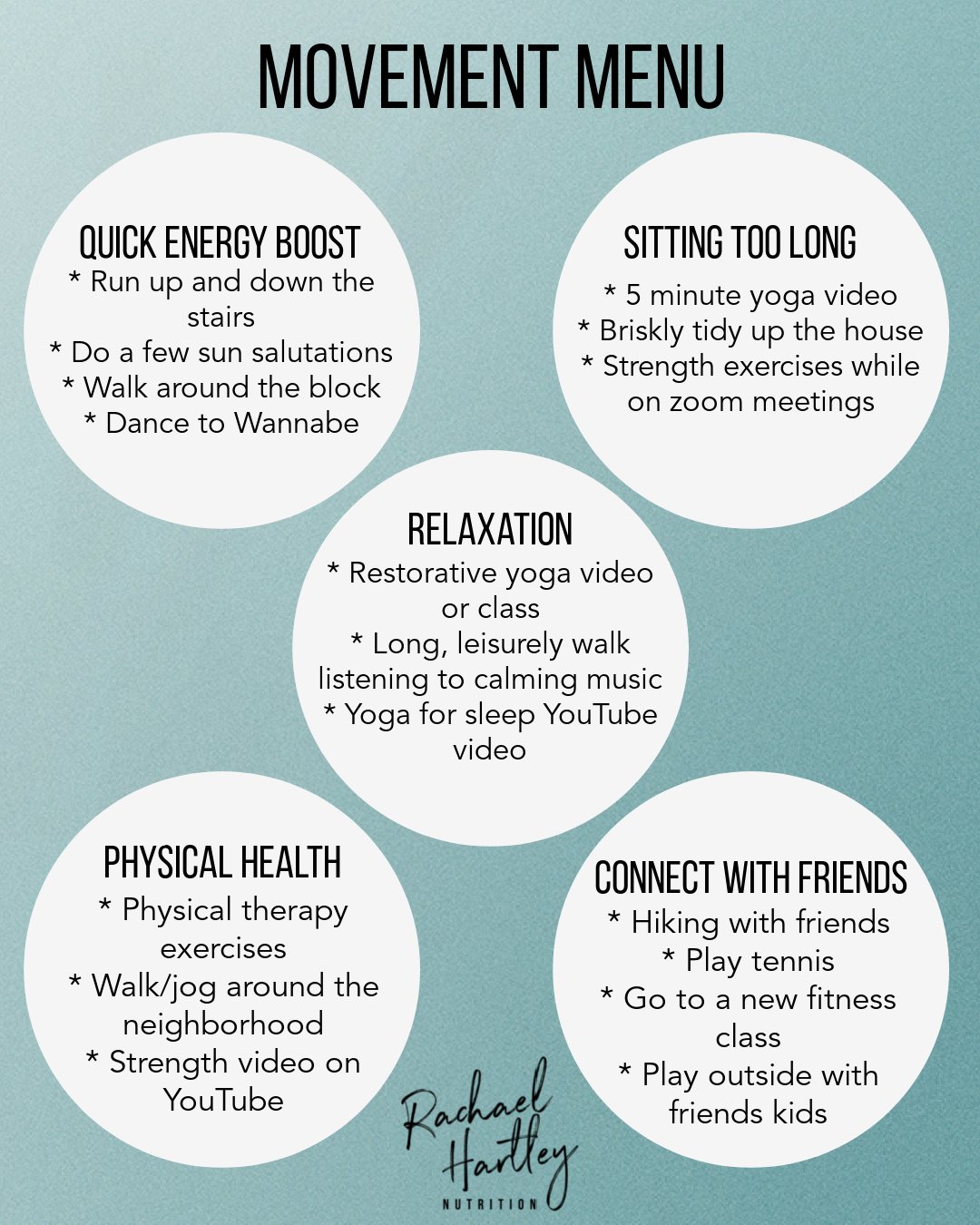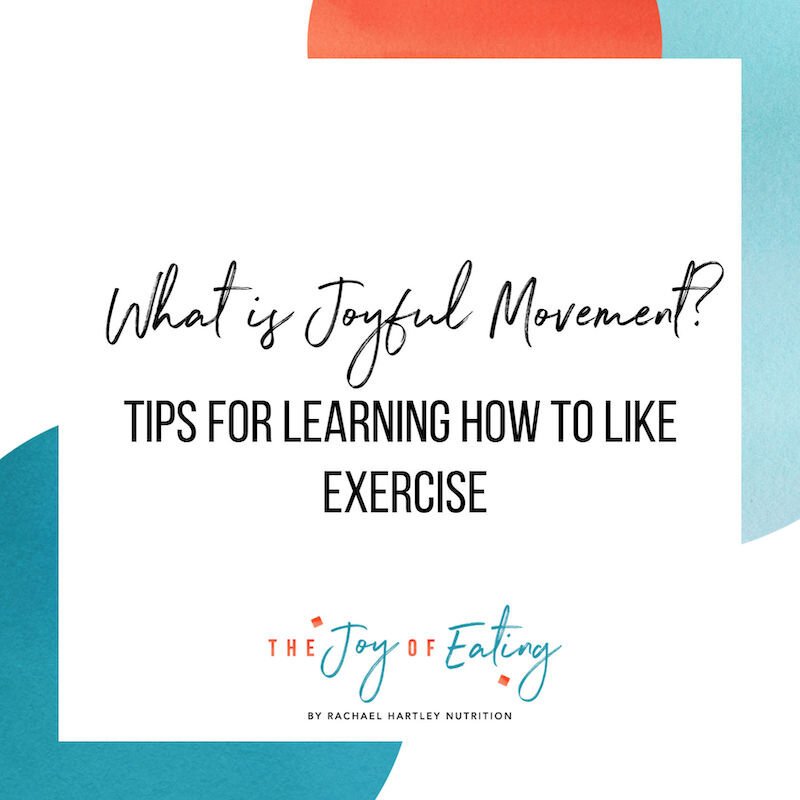Intuitive Movement: How to Build a Movement Menu
Let’s face it - our cultural relationship with exercise is pretty messed up. With no pain, no gain as a mantra, we often overlook pleasurable movement, or shorter exercise sessions we don’t think will count. This post teaches one of our favorite tools for building a more intuitive relationship with movement - how to build a movement menu!
In our culture, most people have a “no pain, no gain” relationship with exercise. Instead of it being viewed as a pleasurable activity, or at the very least a non-punishing activity, we’re taught to look at exercise as a time to push your body to it’s max – to break a sweat and push through discomfort in a fervent attempt to burn calories.
Even if you don’t actually engage in exercise in this intense kind of way, this mindset can still have a major impact on how or if you engage with physical activity. In my practice, I’ve noticed that for most people who are less active, one of the main reasons is because they have high expectations for what “counts” as exercise. It makes sense. If I thought exercise had to always be this painful, exhausting chore, I wouldn’t want to exercise either!
Rather than pushing people to be more active, I think this cultural approach to exercise actually makes us less active. It discounts pleasurable activities people are more likely to engage with in a sustainable way. It also encourages people to overlook gentler types of movement, or physical activity in shorter durations. Diet culture says these types of movement “don’t count,” but research paints a different picture. A 2019 meta-analysis published in the British Medical Journal showed that low intensity movement, like gardening or cleaning the house, contributed to a reduced risk of all-cause mortality. Another 2019 study showed that accumulated exercise was just as beneficial from a cardiorespiratory standpoint as exercising for a longer duration.
In our practice, we love to help clients foster a more intuitive relationship with movement. Similar to intuitive eating, where you listen to your body’s cues to make eating choices, with intuitive movement you listen to your body’s cues to inform movement choices.
One tool we use with clients to help them become more intuitive with movement is a movement menu. Similar to a restaurant menu, where you have different options for the different kinds of meals you might desire (i.e. appetizers, soups & salad, main dishes, dessert, etc), with a movement menu you have options for different types of movement you might desire. I’ve had clients organize their menu in different ways, sometimes based on how much time they have to dedicate to physical activity, others based on what they are hoping to get out of physical activity (i.e. strengthening, destressing, relaxation, etc). What’s most important though is that on the menu, you’re only listing movement that you enjoy, are curious about, or at the very least don’t despise.
Here’s an example of part of a movement menu one of my clients created:
The client who made this list had a history of overexercising then burning out and being fairly sedentary (or injured) for periods of time. In fact, a knee injury had sidelined her for a period of time when she first discovered intuitive eating. After doing quite a bit of work around body image and her relationship with food, she wanted to explore what her relationship with movement could look like when she wasn’t engaging in it for the purpose of weight loss.
Through discussion, she was able to identify three big values guiding her movement choices. First, that she really didn’t like that her job was so sedentary, and felt like movement was one way to help her body feel better and more energized after long days of zoom meetings. Second, as someone who lived alone, and whose social life tended to center around alcohol, she wanted to start making plans with friends that involved movement. Lastly, she did care about her health, namely about preventing osteoporosis (which runs in her family, and she was at risk for with a long history of restrictive eating and amenorrhea), and helping her knee injury. She also recognized that work stress was something that affecting her mental health, and wanted to use movement as a tool to help cope with it. As you can see in looking through her menu, most of her “menu items” are centered around these goals.
In making a movement menu, I think it’s helpful to make sure you have a sprinkling of the following:
Movements you can do for 5 minutes
Structured movement (if that feels safe for you)
Movement as part of life (i.e. walking the dog, gardening, etc)
Social movement
And while I’m no exercise physiologists, I do know that for general health it’s recommended to do a mixture of cardiovascular, strength and stretching. Please note that a.) it’s OK if you’re not doing formal exercise for one or more of these areas and b.) cardio doesn’t have to be vigorous, strength doesn’t have to be lifting massive weights at the gym and stretching doesn’t have to be super bendy, instagram-ready yoga poses.
After making a movement menu, I find it can be helpful to glance at throughout the day, especially when you’re feeling a little fatigued, antsy, or anxious. That’s not to say that movement will always be the solution or what you “should” choose, but it’s worth having it there as an option. I think visiting your menu throughout the day is a helpful reminder that little bursts of movement are an option, as there’s the tendency to discount movement if we don’t think it’s enough to “count.”
To decide what kind of movement sounds best for you, here’s a few questions you can ask yourself:
What sounds enjoyable right now?
What do I have time for?
Is there a type of movement that might be helpful for me right now?
Is there a type of movement I need to prioritize for health reasons, for example physical therapy exercises?
Before making a movement menu, please keep in mind that sometimes the first step to building a healthier relationship with movement is taking a break from it. If reading this feels like too much pressure, that’s OK! This movement menu is designed for people who are ready to bring physical activity back in a more intentional way. If you’re not there yet (or ever) it’s no sweat - literally lol. Movement is a lovely tool, and something that all people deserve access too, but it is not a moral imperative. That said, if movement is something you want to enjoy, I hope this is a helpful tool for you!
Struggling with your relationship with movement? We work with clients virtually and out of our Columbia, SC office, and love to help people rebuild a more peaceful, joyful relationship with movement. Learn more about our practice philosophy and nutrition services to see if we’re a good fit to work together.
If you like this post on how to build a movement menu, follow my Pinterest board on joyful movement.






